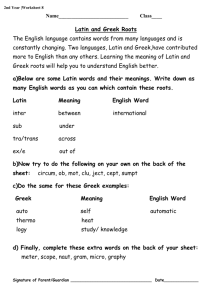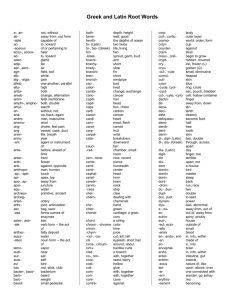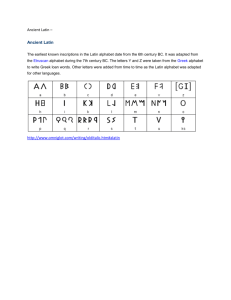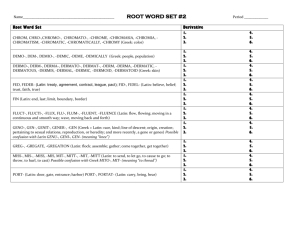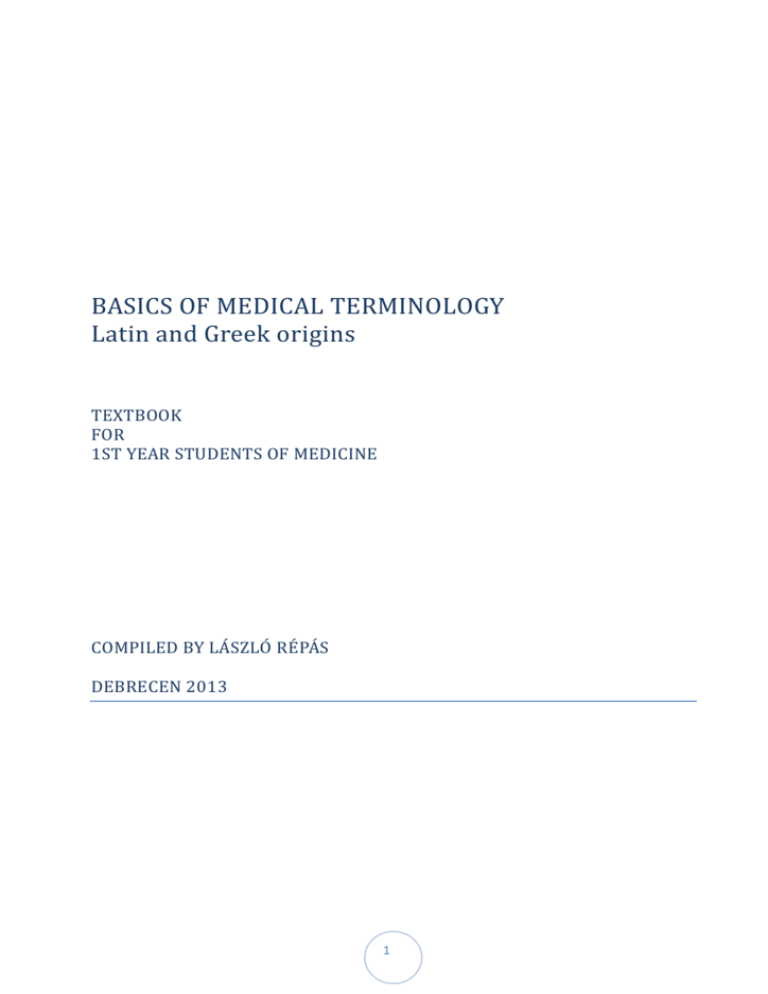
BASICSOFMEDICALTERMINOLOGY
LatinandGreekorigins
TEXTBOOK
FOR
1STYEARSTUDENTSOFMEDICINE
COMPILEDBYLA" SZLO" RE" PA" S
DEBRECEN2013
1
© László Répás, 2013.
www.medi-lingua.hu
All rights reserved.
Cover and Illustrations by Zsolt Tolnai and László Répás
Proofread by Judith Bodnar M.D.
Litográfia Nyomda, Debrecen
www.litografia.hu
ISBN 978-963-08-6589-0
2
Preface
4
Chapter 1 Introduction to medical terminology 5
Chapter 2 Anatomical positions, planes and directions
Chapter 3 Parts of the body
10
15
Grammar 1 Basic elements of Latin grammar
Chapter 4 The skeletal system
15
19
Grammar2 - Singular and Plural, Nominative and Genitive forms 31
Grammar 3 Latin adjectives and grammatical concord
Chapter 5 Regions of the human body
34
36
Grammar 4 Formation of adjectives 39
Grammar 5 Formation of plural adjectives
Chapter 6 Connections of bones
41
43
Grammar 6 Word formation: complex adjectives
48
Grammar 7 Word Formation: Nouns from Verbs
50
Grammar 8 Latin praefixes
Chapter 7 The muscular system
52
54
Grammar 9 - Comparative and Superlative Degree of Adjectives
Grammar 10 - Latin and Greek prefixes related to numerals and
quantities 64
Grammar 11 Latin numerals (1-2000)
65
Grammar 12 Greek prefixes and suffixes 67
Appendix
71
References 90
3
62
Preface
This textbook was written primarily for first year students of medicine at the University of Debrecen
with the aim of providing them a brief introduction into the Latin and Old-Greek background of medical
terminology. Therefore, having only a short time for such a profound topic in the 1st year curriculum,
we concentrate on the parts of vocabulary that are the most important for a first year student. So, the
textbook leads the student step-by-step through the basic terms of anatomical terminology, starting
with the basic terms, planes and directional terms, and then going on to the terms related to the body
parts and regions, continuing with the skeleton and joints, and finally it includes terms related to the
muscular system.
In terms of grammar, the textbook provides only a minimal level of grammar necessary for plural and
adjective formation.
In order to help build a medical vocabulary a number of different exercises follow each vocabulary
unit including matching, fill-in-the-blank, odd-one-out, diagram labeling, crosswords etc.
An online interactive e-learning site related to the textbook also helps students in studying the world
of medical terms. See: www.medi-lingua.hu
We hope that the textbook functions as a useful tool in the field of teaching professional language of
medicine and health sciences.
I am very grateful to my colleague, Emőke Tóth, for her great help in reading the textbook and
participating in the development of new exercises as well as giving valuable pieces of advice during the
editing phase of the textbook.
I would like to thank Judith Bodnar M.D. for proofreading the book and for advice on content related
to English terminology.
Debrecen, August 2013.
László Répás
4
Chapter 1 Introduction to medical terminology
The main sources of medical terminology
Although medical terms have been drawn from many languages, a large majority are from Greek and
Latin. Terms of Greek origin occur mainly in clinical terminology (e.g. cardiology, nephropathia,
gastritis), Latin terms make up the majority of anatomical terminology (Nomina Anatomica) (e.g. cor,
ren, ventriculus). There are, however, terms of different origin, taken from French (e.g. massage,
passage, plaque, pipette, bougie), or from Italian (e.g. varicella, belladonna, influenza).
Greek in medical terminology
It is estimated that about three-fourths of medical terminology is of Greek
origin. The main reason for this is that the Greeks were the founders of rational
medicine in the golden age of Greek civilization in the 5th Century B.C. The
Hippocratic School and, later on, Galen (the Greek from Asia Minor who lived
in Rome in the 2nd century A.D.) formulated the theories which dominated
medicine up to the beginning of the 18th Century. The Hippocratics were the
first to describe diseases based on observation, and the names given by them
to many conditions are still used today, for example, arthritis, nephritis,
pleuritis (pleurisy).
A second reason for the large number of Greek medical terms is that the Hippocrates of Cos 5th c. B.C.
Greek language is quite suitable for the building of compound words.
When new terms were needed, with the rapid expansion of medical science
during the last centuries, Greek words or Latin words with Greek endings
were used to express the new ideas, conditions, or instruments. The new
words follow the older models so closely that it is impossible to distinguish
the two by their forms. Such recent words as appendicitis, creatinine,
cystoscope, epinephrine, streptococcus, and many others do not appear
different from the classical terms. The fact is that about one-half of our
medical terminology is less than a century old. A third reason for using the
Galen of Pergamon 2nd c. A.D. classical roots is that they form an international language.
Latin in medical terminology
Greek medicine migrated to Rome at an early date, and many Latin terms
crept into its terminology. Latin was the language of science up to the
beginning of the 18th century, so all medical texts were written in Latin.
Under the influence of the great anatomical work of Andreas Vesalius, De
humani corporis fabrica (1543), the terminology of anatomy is almost
exclusively Latin.
Andreas Vesalius A.D. 1514-1564
5
Greek alphabet, transcription and pronunciation of Greek letters
Greek letters occur in Physics, Biophysics and other sciences, so it is worth knowing them as well as
because Greek words are numerously present in medical terminology.
Letter
Name
Pronunciation Latin
transcription
/á/
a
/b/
b
/g/
g
/d/
d
/e/
e
/dz/
z
/é/
e
/th/
th
/i, í/
i
/k/
c (k)
/l/
l
/m/
m
/n/
n
/x/
x
/o/
o
/p/
p
/r/
rh
/s/
s
Example
Pron.
ἄνθρωπος
βιός
γαστήρ
δέρμα
ἐγκέφαλος
ζῷον
ἧπαρ
θώραξ
ἱστός
κράνιον
λάρυγξ
μεμβράνα
νεῦρον
ξηρός
ὄργανον
πλευρά
ῥεῦμα
σῶμα
/anthrópos/
/bios/
/gastér/
/derma/
/enkephalos/
/dzóon/
/hépar/
/thórax/
/histos/
/kranion/
/larünx/
/membrána/
/neuron/
/xeros/
/organon/
/pleura/
/reuma/
/sóma/
Latin
transcription
anthropologia
biologia
gastritis
dermatitis
encephalopathia
zoologia
hepatomegalia
pneumothorax
histologia
cranium
larynx
membrana
neuron
xeroderma
organum
pleura
rheuma
somatotrop
Α α
Β β
Γ γ
Δ δ
Ε ε
Ζ ζ
Η η
Θ θ
Ι ι
Κ κ
Λ λ
Μ μ
Ν ν
Ξ ξ
Ο ο
Π π
Ρ ρ
Σ σ
ς
Τ τ
Υ υ
Φ φ
Χ χ
Ψ ψ
Ω ω
alpha
beta
gamma
delta
epsilon
dzeta
eta
theta
iota
kappa
lambda
mu
nu
ksí
omikron
pí
ró
sigma
(end sigma)
/t/
/ü, ű/
/ph/
/kh/
/ps/
/ó/
t
y
ph
ch
ps
o
τραχεῖα
ὕπνος
φωνή
χρόνος
ψυχή
ὦτα
/trakheia/
/hupnos/
/fóné/
/khronos/
/psükhé/
/óta/
trachea
hypnoticum
phonendoscop
chronicus
psychosomaticus
otitis media
Letter
combination
Pronunciation
Latin
transcr.
Greek
example
Pronunciation
Latin
transcription
αι
ει
οι
αη
οη
γγ, γκ, γξ, γχ,
/ai/
/ei/
/oi/
/aē/
/oē/
/ng, nk, nx,
nkh/
ae
i/e
oe
aë / ae
oë / oe
ng, nc,
nx, nch
αἴσθησις
χείρ
οἰσοφάγος
ἀήρ
πνοή
φάλαγξ
/aiszthészisz/
/kheir/
/oisophagos/
/aēr/
/pnoē/
/phalanx/
anaesthesia
chirurgia
oesophagus
aerophagia
eupnoe
phalanx,
phalanges
tau
üpsilon
phí
khí
psí
ómega
6
Exercises
1.Try to transcribe the following Greek words with Latin letters.
Greek
Latin
Greek
κεφαλή
Latin
οἴδημα
cephale
ἀνάμνησις
ἰσχιάς
φάρυγξ
ὑπόφυσις
θεραπεία
ἐπιδερμίς
2. Which Greek letters are these anatomical terms related to? What do they refer to? Search
for them.
lambdoid
hyoid
sigmoid
deltoideus
What is the meaning of the –oid suffix?
3. Some Greek root words
A lot of simple Gr. root words are used in everyday English without our realizing their origin. To
quote just a few: acme, basis, chaos, character, criterion, dogma, drama, echo, enigma, horizon,
phantasia, stigma, thema, etc.
Here is a short list of some basic words used in medical terminology:
adēn – gland
aortē- aorta
bronchos – windpipe
cheir – hand
cholē – bile
derma – skin
gastēr – belly
haima – blood
hepar – liver
hygieia – health
hymen – membrane
kardia – heart
kephalē – head
kranion – skull
larynx – voice box
mania–madness, frenzy
nausea – seasickness
neuron – tendon, nerve
osteon – bone
ophthalmos – eye
pepsis – digestion
pharmakon – drug
pharynx – throat
pleura – side, rib
pneuma – air, breath
psychē – soul
pyon – pus
pyr – fire, fever
sarx – flesh
soma – body
spasmos – spasm
splen – spleen
stoma – mouth
stomachos – stomach
tracheia – windpipe
trauma – wound
4. Do you know what the meaning of the following terms is? Search for them.
dermatitis
splenomegaly
traumatology
gastroscopy
ophthalmoscope
neuropathy
h(a)ematology
psychosomatic
pleurisy
antipyretics
craniotomy
laryngotomy
7
Latin pronunciation rules
We pronounce Latin words here in Hungary differently from the way they are pronounced in Englishspeaking countries. We follow the Eastern-European tradition in Latin pronunciation. The following table
illustrates the differences of pronunciation of Latin words in English and in Hungarian language.
Letter(s)
Example(s)
antebrachium
German/
Hungarian
/a(ː)/
a
/ɑ(ː)/ or /eɪ/
ā
rādix
/aː/
/ɑ(ː)/ or /eɪ/
c+a,o,u, cons.,c+e,i,y,ae,oe
cc+e,i,ae,oe
e
caput, collum, crus,
cervix, circa, cysta
occiput, acceleratio
septum
/k/
/ts/
/kts/
/ɛ/ or /eː/
/k/
/s/
/ks/
/ɛ/, /eɪ/ or /iː/
ē
vēna,
/eː/
/iː/
g
ge,i,ae,oe
h
gluteus,
gingival
homo,
/ɡ/
/h/
/ɡ/
/dʒ/
/h/ or /-/
i
pelvis, saliva,
/ɪ/
/ɪ/ or /aɪ/
ī
vīrus, vītalis,
/iː/
/ɪ/ or /aɪ/
j
jejunum, major
/j/
/dʒ/
o
os, cor, oculus
/ɔ/
/ɒ/ or /əʊ/
ō
per ōs, ōvum
/oː/
/ɒ/ or /əʊ/
qu
liquor, aqua,
/kv/
/kw/
ti+vowel
auscultātiō,
/tsɪ/
/ʃɪ/
u
caput,
/ʊ/
/ʌ/ or /juː/
ū
lūna, cūra
/uː/
/ʌ/ or /juː/
um
bacterium
/ʊm/
/əm/
ae (æ)
Caesar, caesarea
/eː/ or /ɛː/
/eɪ/ or /iː/
aē, aë
aēr, aērophagia
/ aeː/
/ ɑiː/
oe (œ)
oesophagus
/øː/
/iː/
oē, oë
Aloë, diploë
/ ɔeː/
/ əʊiː/
ch
brachium
/kʰ/
/k/
8
English
Reading practice
cytoplasma,
circulatio,
doctor,
vaccina,
lac,
color,
pelvis,
manus,
abortus,
pressio,
radius,
serum,
summa cum laude
physiologia,
infusio,
transfusio
plasma,
consilium;
genius,
siccus,
occiput,
localis,
biceps,
saccus,
focus,
cursus,
tractus,
occasio,
deformatio,
acceleratio,
circus,
leukaemia,
uraemia,
oesophagus,
oedema,
eupnoē,
psychologia,
chromosoma,
physiologia,
apotheca,
therapia,
symphonia,
philosophia,
phagocyta,
pneumothorax,
sulphur
praepositio,
sphaera,
lethargia,
hypophysis,
typhus,
thrombosis,
phlebitis,
nephritis,
stomachus,
aērophagia,
dyspnoē,
Aloē vera,
assimilatio,
sanctio,
separatio,
ambulantia,
aqua,
antiquarium,
antiquitas,
colloquium;
combustio,
foetus,
suggestio,
aphtha,
sanguis,
quinque.
bucca
ligamentum
Did you know?
Believe it or not, more than half of the words in the English dictionary are Latin, and you are speaking,
more or less, Latin every day!
And here are quite a few abbreviations that you may have used without ever having realized their
original Latin content.
Match each Latin abbreviation with its own meaning.
Abbr.
A.D.
a.m.
p.m.
c., ca., cca.
C.V. or CV
cf.
e.g.
et al.
etc.
i.a.
i.e.
N.B.
P.S.
per cent.
Latin
anno Domini
ante meridiem
post meridiem
circa
curriculum vitae
confer
exempli gratia
et alii
et cetera
inter alia
id est
nota bene
post scriptum
per centum
Ph.D.
R.I.P.
stat.
vs or v.
Philosophiæ Doctor
requiescat in pace
statim
versus
Meaning in English
1) "bring together", compare
2) "for example", "for instance".
3) "and others", "and co-workers".
4) "and the others",
5) "among other things".
6) "that is", "in other words".
7) "note well"
8) "after what has been written"
9) "for each one hundred"
10) "Teacher of Philosophy"
11) "may he/she rest in peace"
12) "immediately"
13) "against"
14) "in the year of the Lord" The years of
the Christian calendar era.
15) "before midday"
16) "after midday"
17) "around", "about", approximately
18) "course of life"
9
Chapter 2 Anatomical positions, planes and directions
Body positions
In anatomy all the directional terms are referred to as the so called anatomical position of
the body.
___________ position: The body is in standing position.
___________ position: The body is lying on the belly with the face down.
________________ position is a standard position of the
body: standing erect, facing directly forward, feet pointed
forward and slightly apart, and arms hanging down at the
sides with palms facing forward. This position is used as a
reference to describe sites or motions of various parts of the
body.
___________ position: The body is lying on the back with the face up.
Anatomical planes of the body
Identify the planes
___ Frontal or coronal planes (L. frontalis; pertaining to the forehead;
coronalis; pertaining to a crown ): planes passing longitudinally
through the body from side to side, at right angles to the median
plane, dividing the body into front and back parts.
___Horizontal or transverse planes (L. horizontalis; transversus):
planes passing horizontally through the body, at right angles to the
sagittal and frontal planes, and dividing the body into upper and
lower portions.
___Midsagittal or median plane (L. mediansagittalis): the plane
passing longitudinally through the middle of the body from front to
back, dividing it into right and left halves.
___Sagittal or paramedian planes (L. sagittalis, sagitta; arrow):
vertical planes passing through the body parallel to the median plane (or to
the sagittal suture), dividing the body into left and right portions.
Directional terms
___ anterior or ventral (L. ventralis < venter = belly): directed toward the
front side or situated on the belly surface
___ inferior or caudal / caudad (L. caudalis < cauda = tail): positioned
toward the lower part of the body
___ palmar or volar (L. palmaris< palma; volaris < vola = the front side of
hand): pertaining to the anterior surface of the hand
___ plantar (L. plantaris, planta; sole or bottom of foot): pertaining to the
sole of the foot
___ posterior or dorsal (L. dorsalis < dorsum = back): positioned toward the
back, or towards the back side of the hand or the foot
___ superior or cranial (L. cranialis < cranium = skull) or cephalic / cephalad
(Gr. kephalē; head): positioned toward the head end of the body
10
___ dexter, dextra, dextrum (L.): located on the right side
___ distal (L. distalis; farther): in the limbs away from the trunk
___ lateral (L. lateralis): situated or extending away from the median
plane of the body
___ medial (L. medialis): situated toward the median plane or midline
of the body or a structure
___ proximal (L. proximus; closest): in the limbs, closer to the trunk
___ sinister, sinistra, sinistrum (L., also: laevus): located on the left side
external (L. externus; outer): situated near the outside
internal (L. internus; inner): within or inside
superficial (L. superficialis, superficies; surface): pertaining to the
surface
deep or profundus (L.): deep, situated at a deeper layer of the
structure (especially in muscular system)
parietal (L. paries; wall): pertaining to the wall or outer covering of an
organ or structure
11
Vocabulary 1 - Anatomical positions, planes and directions
Latin
anterior, anterius
caudalis, caudale
cranialis, craniale/
dexter, dextra, dextrum
distalis, distale
dorsalis, dorsale
externus, externa, externum
(planum) frontale / coronale
(planum) horizontale /
transversale
inferior, inferius
(inter)medius, intermedia,
intermedium
internus, interna, internum
English
Meaning in English
anterior
caudal
cranial/cephalic/
cephalad
dexter
distal
dorsal
external
frontal / coronal
plane
horizontal /transverse
plane
inferior
positioned toward the head
right side
in the limbs, away from the trunk
positioned toward the back
situated near the outside
planes dividing the body into front and back
parts.
planes dividing the body into upper and lower
parts
lower
lateralis, laterale
lateral
medialis, mediale
medial
(planum) mediansagittale
palmaris, palmare / volaris,
volare
plantaris, plantare
posterior, posterius
profundus, profunda,
profundum
proximalis, proximale
mediansagittal plane
in between two other structures
inner or inside
situated or extending away from the median
plane of the body
situated toward the median plane or midline of
the body or a structure
the plane dividing the body into right and left
halves
palmar / volar
plantar
posterior
pertaining to the anterior surface of the hand
pertaining to the sole of the foot
positioned toward the back
deep
proximal
deep
in the limbs, closer to the trunk
planes parallel to the median plane, dividing the
body into left and right portions.
left side
situated on the surface of the structure
upper
directed toward or situated on the belly surface
(planum) sagittale
sinister, sinistra, sinistrum
superficialis, superficiale
superior, superius
ventralis, ventrale
middle
internal
directed toward or situated on the belly surface,
front side
positioned toward the tailbone
sagittal plane
left
superficial
superior
ventral
12
Exercises
1. Write the name of the corresponding plane.
1. _______________________________
2. _______________________________
3.________________________________
4. _______________________________
2. Choose and write the corresponding name of the directional term from the list below. In
some cases there are two correct answers, but some do not fit in.
caudal; superior; cranial; inferior; dexter; lateral; sagittal; ventral;
posterior; distal; anterior; dorsal; sinister; coronal; proximal; medial;
longitudinal;
5. _______________________________
6. _______________________________
7. _______________________________
7. _______________________________
8. _______________________________
9. _______________________________
10. _______________________________
11. _______________________________
12. _______________________________
13. _______________________________
14. _______________________________
15. _______________________________
16. _______________________________
13
3. True – False Examine each of the following statements. If the statement is true, write T; if
false, write F in the first blank, and then correct the statement by replacing the underlined
word in the second blank.
E.g. The wrist is distal to the elbow.
_T___ __________
A midsagittal plane divides the body into equal dexter and sinister parts.
____
__________
A horizontal plane divides the body into anterior and posterior parts.
____
__________
The chest is inferior to the belly.
____
__________
The little finger is dexter to the thumb.
____
__________
In anatomical position the palm is turned to the back.
____
__________
In the prone position, a person is lying face-up.
____
__________
4. Odd One Out Eliminate the one term that does not fit in with the rest. Explain your choice
briefly.
palmar – ventral – caudal – anterior
_____________________
plantar – sagittal – horizontal – frontal
_____________________
cephalic – superior – distal – cranial
_____________________
5. Synonyms Write a word that means the same as each of the following.
dorsal
____________________
cranial
_____________________
inferior
____________________
frontal
_____________________
palmar
____________________
anterior
_____________________
6. Opposites. Write a word that means the opposite of each of the following.
superior
____________________
external
_____________________
profundus
____________________
lateral
_____________________
volar
____________________
dexter
_____________________
plantar
____________________
proximal
_____________________
7. Fill in the blanks with the appropriate word
The thumb is on the ____________ side of the hand, the little finger is on the _________. Pectoralis major
muscle is a surface muscle over the pectoralis minor muscle so its position is termed as _________. The
toes are at the _____________ part of the lower limb. The elbow is _______________ to our wrist. The
inner part of the ankle is the ________________ malleolus, the outer one is _____________ malleolus.
8. Latin proverbs
Cogito ergo sum.
Veni, vidi, vici.
Errare humanum est.
Aquila non captat muscas
14

